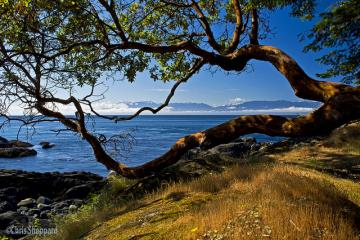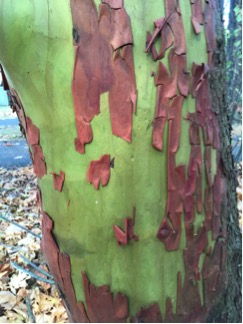
Common Names:
Arbutus, madrone, Pacific madrone
First Nation Names:
qaanlhp (Hul’q’umi’num) (1)
Family:
Ericaeae (heather)
Caution(s): None.
Identification:
Arbutus is a broadleaf evergreen tree that can reach 6-30 meters in height. The bark is chartreuse and smooth, and as the tree ages the bark turns a deep brown-red color and peels off. It often grows with many stems extending from a central base and has the appearance of a shrub. (2) The arbutus leaves are evergreen, meaning they retain their leaves throughout the year. During the summer, the areas of the bark which are exposed to the sun peel off to reveal a younger green bark underneath. As the bark ages, it will turn golden. (3) The leaves can range from egg-shaped to elliptic, grow 5-15 cm long in length with a dark shiny surface above and a whiter green on the underside. The flowers of arbutus appear in large drooping clusters shaped like little urns. The flowers range in color from white to pink and smell like honey. The fruit of the arbutus are berries which are round in shape and range in color from orange to red. The berries are edible but are not often eaten due to their bland taste.


Figure 2: Arbutus leaves and berries Figure 3: Arbutus bark during shedding phase
Current Distribution and Local Habitat:
Arbutus trees can be found in dry open forests, rocky slopes on coarse or shallow soils in the lowland and montane zones. It is found along the Pacific Coast of North America from Southwest British Columbia to Southern California. Arbutus is a shade-intolerant, drought-intolerant species that is seldom found far from the ocean shore. (4)
Ethnobotanical Uses:
The bark and leaves of the arbutus tree have medicinal qualities. The bark can be used to treat bladder infections, stomach aches, cramps and colds. Those suffering from a cold can chew the leaves to create a juice that will treat a sore throat. The leaves and the bark both have astringent properties; the leaves can be used as a poultice on burn wounds and the bark can help treat wounds. The inner bark was used by the WSANEĆ to create dresses while the berries were dried and used as decorations. (5) The bark has high levels of tannin which make it useful as a dye, and traditionally it was used to tan and cure hides. (6) The arbutus played a pivotal role as an anchor in the flood story by WSANEĆ peoples. As the water levels rose, the people tied their rope to the arbutus tree on top of the mountain until they were left floating above the mountain. It is due to the flood story that the arbutus tree was regarded with respect and its wood was not used for firewood. (7)
View a presentation on how to make Arbutus bark soap here
UVic Campus Location(s): It can be found in a variety of places on campus, but it tends to be found in sites that are less groomed and more natural. It can be found specifically in the following areas: Finnerty Ravine, Haro Creek, Mystic Vale, Hobbs Creek and Bowker Creek.
Written by Carrie Booth
Figure references:
Figure 1: Image used with permission from artist.
Figures 2 and 3 taken by Carrie Booth, November 2017.
References
- First Voices (2013). Retrieved from http://www.firstvoices.com/ on November 6, 2017
- McGregor, R. R., Sakalidis, M. L., & Hamelin, R. C. (2016). Neofusicoccum arbuti: A hidden threat to arbutus menziesii characterized by widespread latent infections and a broad host range. Canadian Journal of Plant Pathology, 38(1), 70-81. doi:10.1080/07060661.2015.1135476
- Native Plant PNW. Pacific Madrone, Arbutus menziesii. Retrieved from http://nativeplantspnw.com/pacific-madrone-arbutus-menziesii/ on November 7, 2017.
- Harrop-Archibald, H. (2007) University of Victoria Natural Features Study: Bowker Creek, Cunningham Woods, Upper Hobbs Creek/Mystic Vale. Restoration of Natural Systems Program.
- Na’tsa’maht Indigenous Plant Garden. (2017). Retrieved from: http://camosun.ca/sustainability/garden/plant-id.html
- Parish, R., 1948, Thomson, S. M. 1., Coward, G., Canadian Forest Service, Canada-British Columbia Partnership Agreement on Forest Resource Development: FRDA II, & British Columbia. Ministry of Forests. (1994). Tree book: Learning to recognize trees of british columbia (2nd ed.). Victoria, B.C: Ministry of Forests.
- Horne, J. (2012). WSANEC: Emerging land or emerging people. University of Victoria.
Project Status:
Year:
Associated Projects:
Image:

